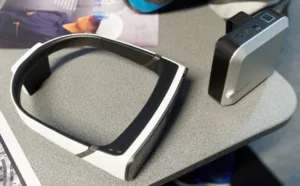 3DRudder’s Motion controller. Image:Meko
3DRudder’s Motion controller. Image:Meko
3D Rudder has developed a foot pad that can be used to control movement in VR games. Tipping the board moves in the appropriate direction and the board can also rotate to allow that movement. By tipping one foot up and the other down, vertical motion can be controlled. In this way, most movement can be achieved without the use of the hands. The controller costs €179.
 The A/R coating makes the brush strokes on Artify’s Art Display are very prominent. Image:Meko
The A/R coating makes the brush strokes on Artify’s Art Display are very prominent. Image:Meko
Artify is a French company that has developed a flat-panel based art display using a Samsung commercial 55″ UltraHD display. The Samsung was chosen because of the contrast and the good performance of the A/R coating. Artify competes with Meural and licenses content from museums and art galleries. It has a range of different frames and cosmetic solutions for the display. The company said that it would sell the displays for around €3,000 but is working on a leasing model at €300 to €500 per month depending on the content.
Barco was at the show with partners including Immersion of France. There was no hardware that was new since ISE, but the HDX-4KFlex was being shown in France for the first time. The F90 was being shown in an active 3D rear projection mode and there was also a video wall using the latest cubes based on laser projection. We were impressed with the thinness of the bezels, but we heard that they were not the slimmest option, which can give a between displays gap of just 0.1mm. Impressive.
Daqri’s new glasses will be available from June as a development kit. Image:Meko
Daqri was showing its latest helmet and also a mock up of a new set of AR glasses that is under development. The glasses should be available in June as a development kit for around $5,000. The glasses have the same sensors as the helmet, but weigh 300 gms. The connection to the control box is said to use a USB Type-C connection back to the box, that uses the DisplayPort Alt mode to deliver the graphics to the headset. The controller has a fingerprint sensor for user identification and security.
Daqri also told us that it is having good success in HUDs, with a major project won with Jaguar Land Rover. It also told us that it is doing well with its concept of ‘software defined light’ using ‘virtual lenses’.
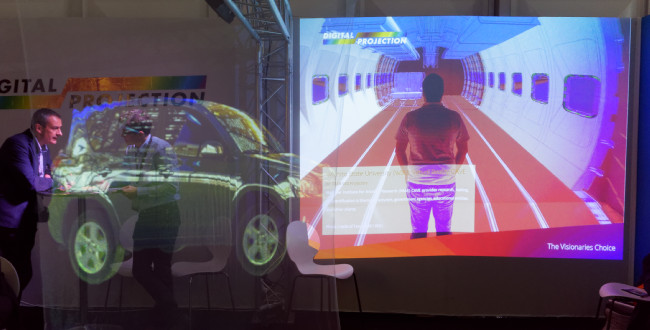 Digital Projection used a transparent screen (left). Image:Meko
Digital Projection used a transparent screen (left). Image:Meko
We didn’t have time to stop by, but we noted that Dassault was showing its homebyme.com home design and furnishing website.
Digital Projection was at the show, but did not have any new hardware since the recent ISE show. The company was showing the suitability of its projectors for A/R and VR applications as well as caves. One of the projectors was using a ‘holographic’ (well, transparent, anyway) projection screen.
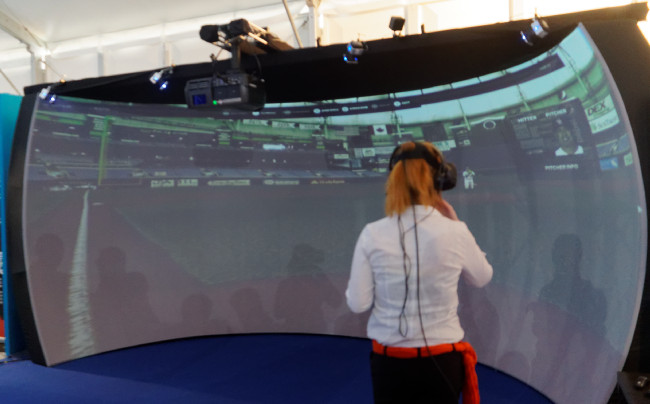 Eon showed this virtual baseball training system for professional players. Image:Meko
Eon showed this virtual baseball training system for professional players. Image:Meko
Eon Reality is based in LA, but has sixteen staff based in Laval, and is a system integrator that specialises in developing complete systems and turnkey solutions for AR and VR applications. The company does a lot of work in training and simulation. The first simulator that we looked at was a baseball simulator that was developed with the professional baseball league in the US and that uses a portable projection-based display system. The system uses actual video and precise data from individual players in the league so that professional players can practice against a simulation taken directly from the specific player (e.g. pitcher) that they are intending to play.
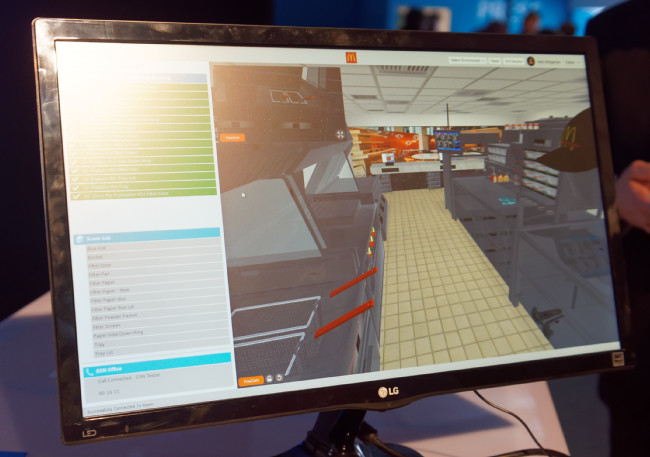 Mcdonalds is already using this VR-based virtual training system. Image:Meko
Mcdonalds is already using this VR-based virtual training system. Image:Meko
Eon also had a system for training servers and operators in QSRs based on using VR headsets. The trainer can see the trainee’s point of view or look at an overview of the virtual situation so that remote trainers can perform training without needing to be physically present, and without a physical training location. The display also shows the steps and processes. The system is already in use with McDonalds.
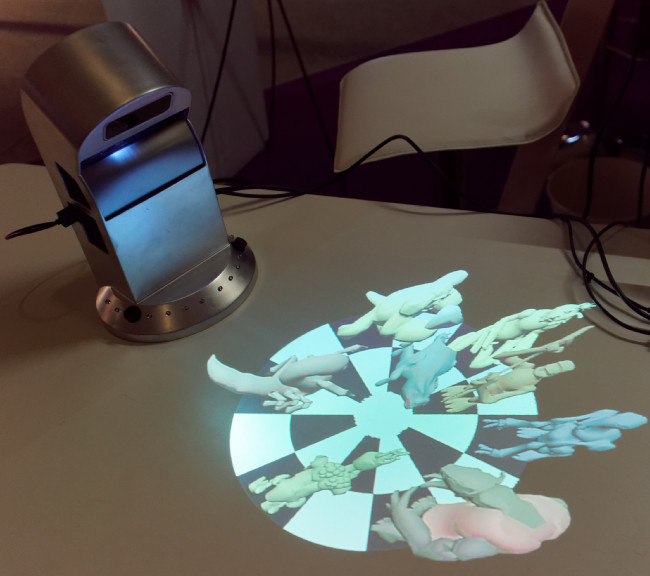 Hololamp’s projector uses Leap Motion and Voice Input. Image:Meko
Hololamp’s projector uses Leap Motion and Voice Input. Image:Meko
Hololamp is a start up that is developing a 720P DLP-based pico projector that can map objects onto a flat surface and uses cameras and Leap Motion technology to track the user’s hands. The company expects applications in sales promotions and to consumers for games, so has a target price of €600. The aim is to have the device also respond to voice commands.
 Microsoft has this rig to capture what the viewer sees and can combine the video with the images from the Hololens. Image:Meko
Microsoft has this rig to capture what the viewer sees and can combine the video with the images from the Hololens. Image:Meko
Microsoft was at the event giving demos of the Hololens. Our attention was caught by a rig that the company has developed that allows developers to ‘see what the viewer is seeing’. It takes, apparently, some effort (and a big PC in the back, hence the wires in the picture) to combine the video stream from the camera with the content from the Hololens.
As you can imagine, NVidia has been doing a lot of work to develop foveated rendering to optimise the use of GPUs in VR and allowing systems with less raw power to be used for VR and other applications. The company said that when it started work (with SMI), it simply reduced the resolution in the areas of peripheral vision, but this was quickly obvious to the viewer because of the ‘blocky’ look. One way of dealing with the ‘blockiness’ while not increasing the data needed is to blur the image, so the group tried a radially increasing gaussian blur to the image. Although this gives a slight ‘tunnel vision’ effect, the effect was much better than the block approach. However, it was realised that the blur was also reducing the contrast, so another process was built in to boost the contrast back to the original level. At this point, viewers could no longer see the difference between the full resolution and lower resolution versions. Using the technique, a third to a fifth of shaders could be eliminated, saving power. There is a small overhead to the process, but much less than running the full resolution render.
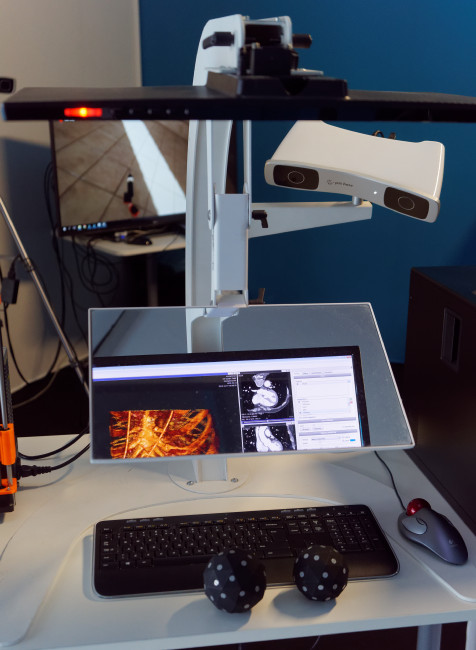 PS Tech has a tracker (top right) that can see motion of the balls (by the keyboard) to allow manipulation of the 3D image. Image:Meko
PS Tech has a tracker (top right) that can see motion of the balls (by the keyboard) to allow manipulation of the 3D image. Image:Meko
PS-Tech is based in Amsterdam, the Netherlands, and was showing its optical tracking systems which uses its own tracker. The system is already in daily use in medical applications and staff showed us a fascinating demo of how a surgeon might use a CT scan to preview a procedure. The company has a tracker that is used with two hand held ‘balls’ that are held under a special mirror which shows an image from a passive stereo 3D LCD. The hands are used under the display to control movement and navigation through a 3D model. In medical application, active 3D is not acceptable, so special displays are used. Endoscopy is often performed in 3D.
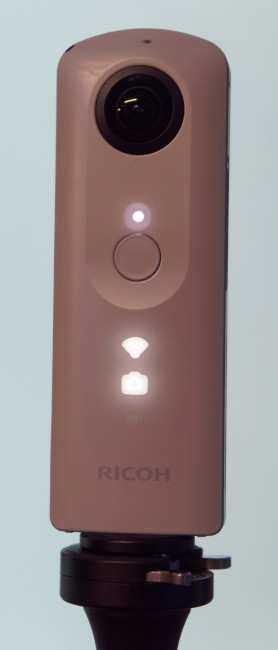 Ricoh’s Theta is available in two versions. Image:Meko
Ricoh’s Theta is available in two versions. Image:Meko
Ricoh was at the show to demonstrate the two Theta 360º cameras, the SC which supports the live streaming of 360º video content, whereas the S model does not.
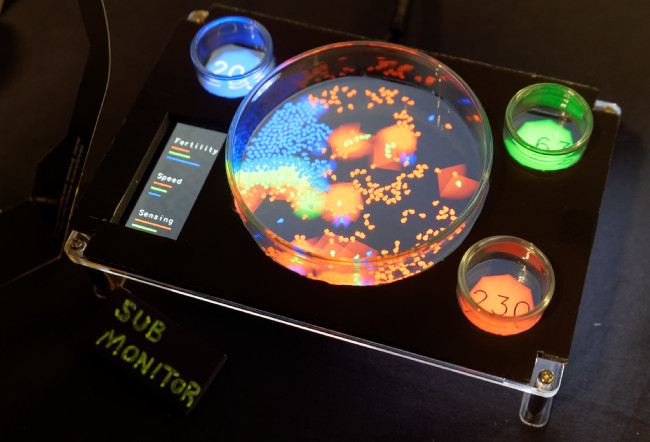 Ritsumeikan University used a mapped projector to show this ‘Virtual Petri Dish’. Image:Meko
Ritsumeikan University used a mapped projector to show this ‘Virtual Petri Dish’. Image:Meko
A group from Ritsumeikan University was showing how software could be used to create ‘virtual petri dishes’ so that biology students could conduct experiments using ‘artificial creatures and is known as the MitsuDomoe system. An image can be projected onto the ‘petri dish’.
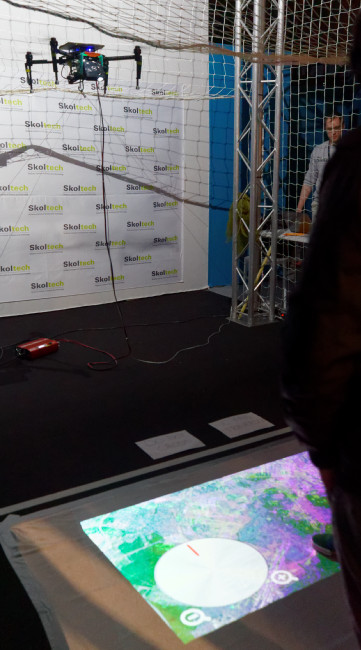 Skolkovo Drone tracks the viewer’s foot movement. Image:Meko – click for close up.
Skolkovo Drone tracks the viewer’s foot movement. Image:Meko – click for close up.
A group from Skolkovo University in Russia has developed a projection system that was integrated into a drone, along with a camera system that could watch the image that was projected and track the foot movements of the viewer. The drone used a Dell microprojector.
 The group that has developed this table tennis tracking system are working on commercialisation. Image:Meko
The group that has developed this table tennis tracking system are working on commercialisation. Image:Meko
A start-up from Berlin (they weren’t listed in the catalogue) was showing a demonstration of an application that could track a table tennis ball using a projector. The group is working out how to commercialise the technology for training or for games.
Technicolor has its main R&D headquarter just an hour away from Laval in Rennes and, last year, we took advantage of the closeness to visit (Plenty to See from Technicolor in Rennes). This year, the firm had a couple of demonstrations of VR and augmented reality. One was a VR experience intended to simulate the experience of the movie, Gravity. The simulation allowed two separate individuals to be in the scene and communicate and it combined generated objects and 360º photography. It was pretty impressive especially as it tracks the users hands and body movements. The simulation used a combination of on and offline assets. The company will have more to show at NAB.
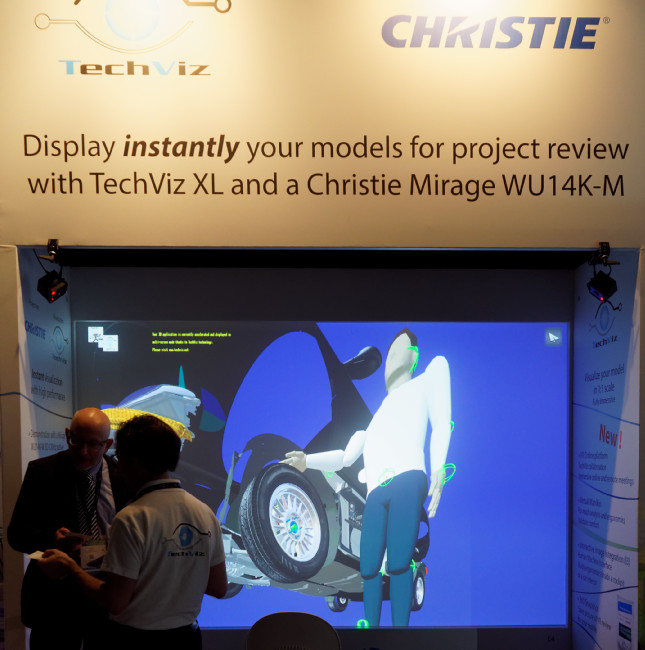
Techviz was working with Christie and showing a Christie Mirage WU14K-M projection system which it was using to show how it is able to use CAD data from many different CAD applications (more than 200, we heard) with no data conversion. Applications include, for example, using models of production equipment and processes to check on the implications for assembly ergonomics.
Thales was at the show to talk to companies about using the Microsoft Hololens in commercial applications.
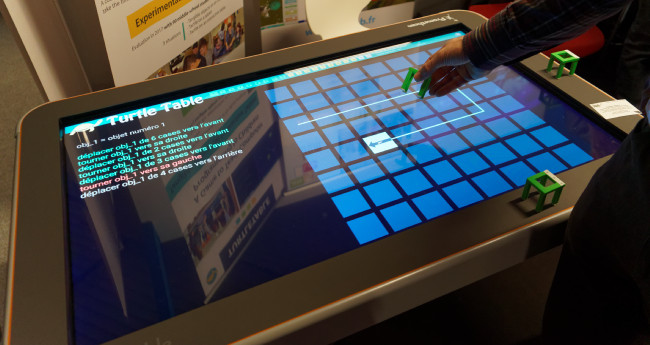 The TurtleTable is for teaching programming. Image:Meko
The TurtleTable is for teaching programming. Image:Meko
TurtleTable was showing an educational platform for teaching children how to programme using ‘turtle graphics’, but implemented with a Promethean touch table and using objects with special conductive pads on the bottom (to create specific shapes). The table is a very suitable device for collaborative learning like this.
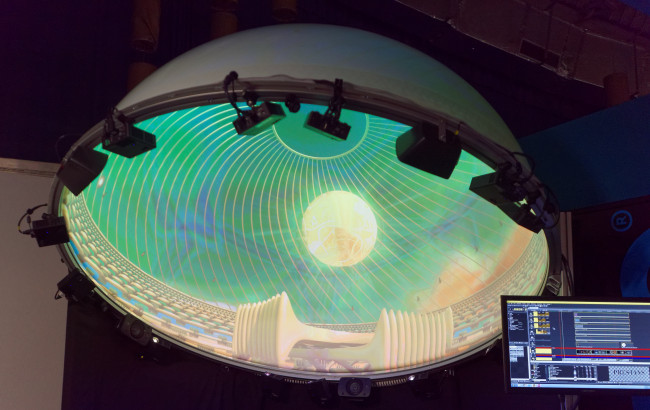 Vioso’s pico-projector-based dome. Image:Meko
Vioso’s pico-projector-based dome. Image:Meko
Vioso of Düsseldorf was at the show with its partner, Unified AV of France, to demonstrate its edge blending software being used in a dome application using 12 picoprojectors and with auto calibration and a demonstration we have seen before, but it’s still impressive. As we reported from ISE, Digital Projection is using the software in its projectors now. Unified is using the software to build caves and domes and has created a number of domes for detailed simulation in motor sport.
VR-BNB is a French service that is working with HP, Immersion, Barco and Nvidia to create a platform for accessing VR spaces and meeting/conference rooms on a rental basis (AirBNB for VR is the concept).
 X-Rite’s VLB shows a render on the display at the back based on a scan of the front item Image:Meko
X-Rite’s VLB shows a render on the display at the back based on a scan of the front item Image:Meko
X-Rite was on the booth of its reseller, Anticyp Simulation, which was showing the ‘Virtual Light Booth’. This is a box that has an UltraHD/4K (details were scarce) display on the back and special lighting on the inside of the box and is intended to allow product developers to capture the surface of materials that are used in products and then compare the materials to the virtual image that was rendered on the back display. X-Rite calls the system ‘Total Appearance Capture’. The system costs ‘around $75K’ and is intended for companies that are very concerned about the appearance of their simulations and we heard that it is already in use with Jaguar Land Rover. The pixellation on the display was apparent in some of the display of fine textures, and X-Rite told us that it plans to offer an upgrade version with an 8K display ‘later’.

